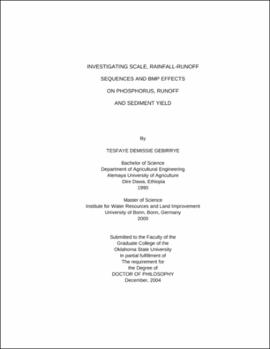| dc.contributor.advisor | Storm, Daniel E. | |
| dc.contributor.author | Gebirrye, Tesfaye Demissie | |
| dc.date.accessioned | 2013-11-26T07:43:14Z | |
| dc.date.available | 2013-11-26T07:43:14Z | |
| dc.date.issued | 2004-12 | |
| dc.identifier.uri | https://hdl.handle.net/11244/6408 | |
| dc.description.abstract | Scope and Methods of Study: 1) Scale effects on phosphorus (P) loss and runoff depth from pastures were investigated by summarizing water quality data from 19 research projects. Spatial (area) and temporal (days after litter application) scales ranged from 0.5 to 80000 m^2 and 1 to 355 days, respectively. (2)Rainfall-runoff sequence (RRS) effects on dissolved reactive P (DRP) in runoff from pastures were studied in a greenhouse experiment using a 2x2x3 factorial arrangement of soil test P (STP), surface application of poultry litter, and RRS. (3)Impacts of two best management practice (BMP) and land use change scenarios (strip-cropping, terrace, forestation) on runoff and sediment yield from the Legedadi Reservoir watershed in central Ethiopia were assessed using the Soil and Water Assessment Tool model. | |
| dc.description.abstract | Findings and Conclusions: 1)Spatial scale had significant effects on runoff depth, DRP and total P (TP) concentration, DRP and TP load from pastures. Exceptions were DRP and TP concentration from control pastures. DRP and TP load increased with area due to an increase in runoff volume. DRP and TP concentrations decreased with area probably due to dilution associated with the increased runoff volume. Temporal scale effect with an exponential decrease existed for DRP and TP concentration from both poultry litter treated and control pastures. The existence of spatial and temporal scale effects suggested that a simple averaging procedure based on homogeneous assumption may not be a suitable method for transferring data from plot- or field-scale study to larger scale. 2) Poultry litter, which masked the significant STP effect on DRP prior to litter application, is the primary source of DRP in runoff immediately following litter application. For consecutive RRS, a rainfall event without runoff reduced litter DRP loss in the first runoff event by more than 50%. Effect of poultry litter application on DRP decreased exponentially with time. 3) Forestation had the greatest impact in reducing sediment yield, and surface runoff, and increasing base flow compared with existing conditions. Although terracing and strip-cropping reduced sediment yield, they had little impact on watershed hydrology. This study showed that a watershed modeling approach, in the absence of plot- and field-data, is a useful tool that can be used in the planning and selection of BMP or land use change to reduce surface runoff and sediment yield. | |
| dc.format | application/pdf | |
| dc.language | en_US | |
| dc.rights | Copyright is held by the author who has granted the Oklahoma State University Library the non-exclusive right to share this material in its institutional repository. Contact Digital Library Services at lib-dls@okstate.edu or 405-744-9161 for the permission policy on the use, reproduction or distribution of this material. | |
| dc.title | Investigating scale, rainfall-runoff sequences and BMP effects on phosphorus, runoff and sediment yield | |
| dc.contributor.committeeMember | Smolen, Michael D. | |
| dc.contributor.committeeMember | Hamilton, Douglas | |
| dc.contributor.committeeMember | Zhang, Hailin | |
| osu.filename | Gebirrye_okstate_0664D_1138.pdf | |
| osu.accesstype | Open Access | |
| dc.type.genre | Dissertation | |
| dc.type.material | Text | |
| dc.subject.keywords | rainfall | |
| dc.subject.keywords | phosphorus | |
| dc.subject.keywords | runoff | |
| dc.subject.keywords | sediment | |
| dc.subject.keywords | soil | |
| thesis.degree.discipline | Biosystems Engineering | |
| thesis.degree.grantor | Oklahoma State University | |
